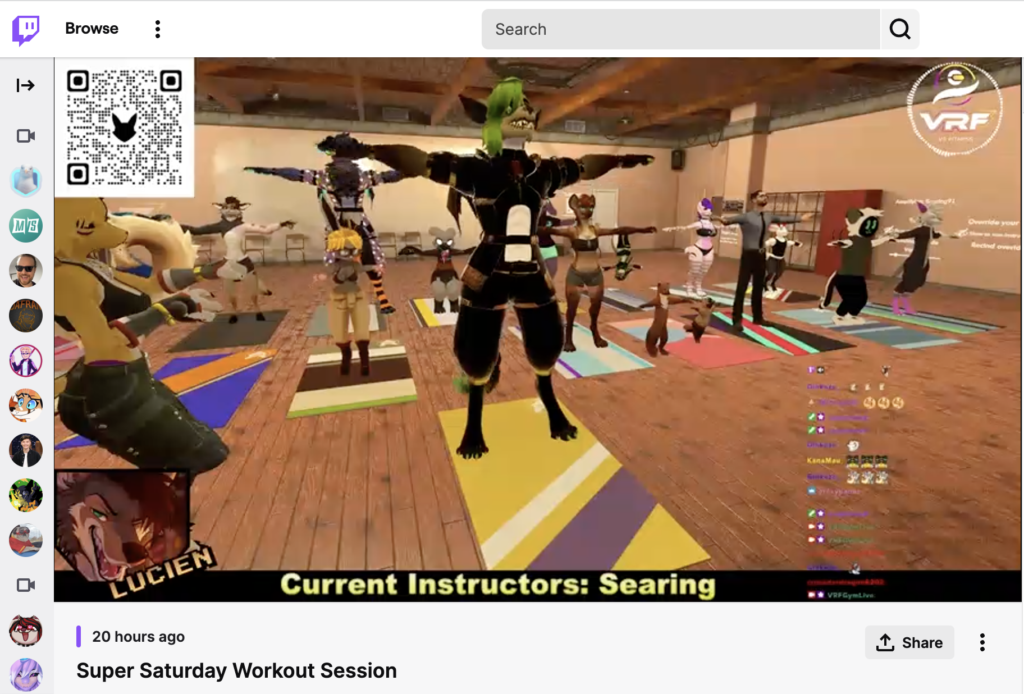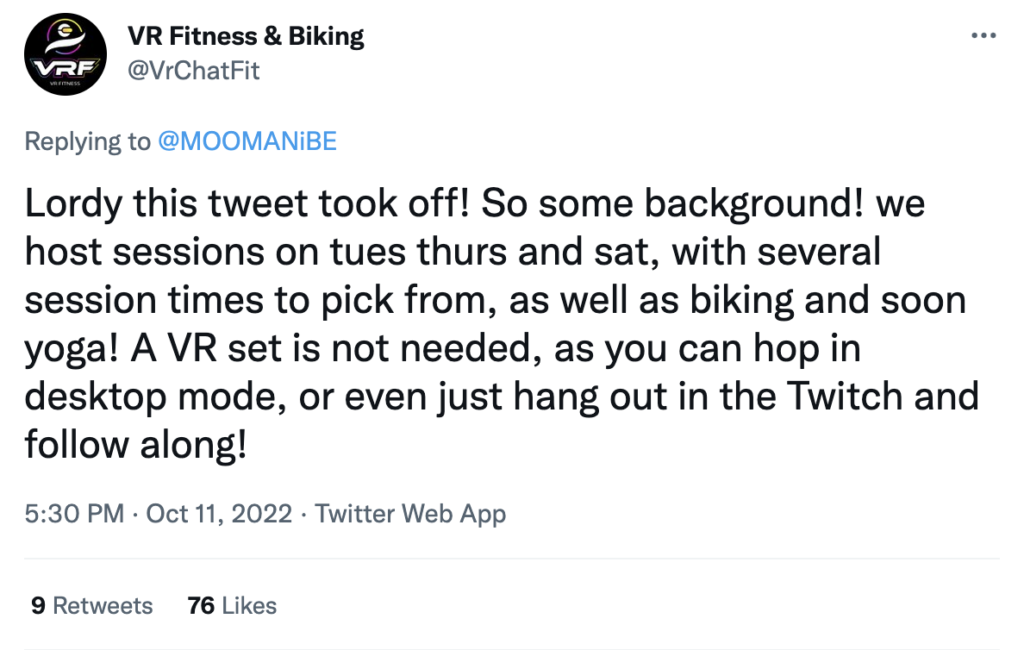Have you ever wondered what gyms will look like in the metaverse?
Hint: They will be full of furries, user generated, and livestreamed on Twitch.
So, without further ado, here is a sneak preview of the future of fitness:

The above, in case you don’t know, is a Twitch livestream of the VR Fitness and Biking gym in VRChat. The club is run, and frequented, by furries, but all are welcome to join. Plus, the sessions are highly engaging – to the point that you want to buy a VR headset just to workout.
Along those lines, the following outlines what brands and marketers can learn from furries in the metaverse. The objective is to illustrate three principles of effective marketing strategies in virtual worlds.
Here is what you need to know:
- The furry community is often misidentified as a sexual fetish subculture
- Effective marketing in virtual worlds is about experimentation
- Open gardens help brand authenticity grow in the metaverse
Embrace chaos
Furries are a diverse group of people who have an active interest in animal characters with human qualities. While mainstream culture has sensationalized the community’s adult element, furry fandom is much more than just a sexual fetish.
But what do furries have to do with mainstream marketing activities in virtual worlds? Well, simply put, furries are trendsetters in the non-gaming metaverse.
For example, the furry community is at the vanguard of virtual reality (VR). From spinning up creative worlds to launching ventures like a fitness and biking gym in VRChat (VRC), furries just get it. Most importantly, many furry creations serve as de facto models for engaging audiences without relying on popular gaming content.
What is their secret? Well, among other things, furries fully embrace creative experimentation. This state of playful openness is critical as today’s metaverse is a constant work-in-progress. Marketing strategies should embrace the same creative, chaotic energy. Especially since, failing to do so is a death kneel for authenticity.

Case in point, Facebook’s (Meta) Horizon World recently unveiled legs, yes legs, on their virtual avatars. Only to later admit they were animations from motion capture, not live VR. The resulting jeers from social media further indicate that Meta is bungling promotion of its $15 billion metaverse investment.
More importantly, according to internal documents, most Horizon Worlds visitors do not return after the first month. Additionally, only 9% of worlds on the platform receive 50 visitors.
Meta’s heavy-handed attempt to promote a polished product, as opposed to an open social platform, is collapsing under its own weight. Mostly because the current Web 3.0 era prizes continuous experimentation over commercialization.
The furry community, on the other hand, accepts that most virtual worlds are necessarily messy and unfinished. As a result, furries are leading a creative wave of authentic experiences which illustrate what is possible in the metaverse. It also means if you are uncomfortable with creative experimentation in virtual worlds, your marketing budget is much better invested elsewhere.
Inclusivity 3.0
Furries create anthropomorphized animal characters called fursonas with whom they identify and serve as their avatars. Creating a fursona is one of the most universal behaviors in the furry community. Fursonas also play a crucial role in bringing all types of people together – regardless of diverse backgrounds and demographics.
Similarly, people navigate virtual worlds via an avatar, which frees them from the constraints of their real-world identity. In that, virtual experiences empower you to be all or none of the things you are in the physical world.
While inclusivity in the physical world is about opening doors to all people, regardless of (mostly) immutable identity attributes. In digital environments, all forms of identity are fluid. So, inclusivity is more about empowering the maximum number of people to fully participate. Inclusive marketing experiences in the metaverse should avoid walled gardens, as a result.
To demonstrate, Degree, a deodorant brand, launched an April 2022 activation centered on improving inclusivity and representation in the metaverse. Yet, Decentraland requires a crypto wallet to fully participate in-world. Where crypto wallet ownership creates an unequal barrier to access, which contradicts Degree’s intended message of inclusivity.
Comparatively, furry fandom is open to all. Furry activities in the metaverse also keep the same energy: The VR Fitness & Biking club is hosted in VRChat but you can participate without VR or by following along on Twitch. Authentic brand presence in virtual worlds requires similarly open gardens to grow.

Follow the fandoms
Furries tend to get an unfair label as fetishists, however, the subculture is about playful escapism. The community expresses itself by drawing, authoring stories, and dressing up in costumes called fursuits. Where the metaverse is yet another canvas for creative expression.
Furries are among the most knowledgeable, and helpful, when it comes to the complicated tools used to import fursonas and build worlds in platforms like VRChat. As a result, the community is behind several standout creations which routinely attract non-furries.
Likewise, brands and marketers must identify which virtual worlds fandoms like furries are calling home. This exercise is especially valuable in non-gaming worlds since you cannot rely on popular game content to point the way forward. So, until Yelp includes metaverse locations, fandom inspired creator activity is the surest indicator of where the audiences are, and where your marketing should follow.
